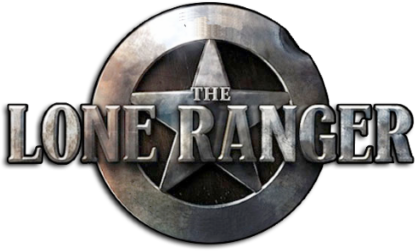No edit summary |
|||
| Line 27: | Line 27: | ||
[[File:JohnHart.jpg|thumb|John Hart]] |
[[File:JohnHart.jpg|thumb|John Hart]] |
||
| − | In 2003 the WB television network sought to create a new Lone Ranger TV series, and commissioned a two-hour pilot episode. [[Chad Michael Murray]] was cast as the Ranger. The producers changed multiple aspects of the story, including the Ranger's real name (to Luke Hartman), to try and attract the teenage ''Dawson's Creek'' audience. The pilot was not well received, and a new series never produced. |
+ | In 2003 the WB television network sought to create a new Lone Ranger TV series, and commissioned a two-hour pilot episode. [[Chad Michael Murray]] was cast as the Ranger. The producers changed multiple aspects of the story, including the Ranger's real name (to Luke Hartman), to try and attract the teenage ''Dawson's Creek'' audience. The pilot was not well received, and a new series never produced.[[File:Murray.jpg|thumb|left|Chad Michael Murray]] |
==Films == |
==Films == |
||
Revision as of 00:34, 9 February 2011
The Lone Ranger is the last survivor of a group of six Texas Rangers. He wears a mask to conceal his identity as he travels the West fighting for law and order.
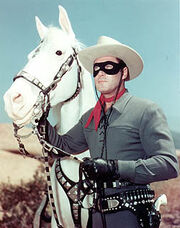
The Lone Ranger (Clayton Moore) and Silver
Origin
Though there have been several variations of the Lone Ranger's origin over the years, the basic story has remained the same.
Six Texas Rangers, including brothers Dan and John Reid, were tracking a gang of desperadoes led by the notorious Butch Cavendish. Led by a tracker named Collins, who was actually a member of the Cavendish gang, the Rangers were lured into a canyon called Bryant's Gap, and ambushed. Except for young John Reid, they were all slaughtered.
Reid managed to crawl to safety near a water hole where he was later found and nursed back to health by a friendly Indian named Tonto. Tonto remembered Reid, who had once saved Tonto himself. "You Kemosabe," said Tonto; "it mean 'trusty scout.'" Tonto now vowed to stay with him as the "lone" Ranger vowed to avenge the deaths of his brother and their comrades.
Six graves were left to hide the fact that one man lived to fight. Realizing that if his identity were known, he would be a marked man, Reid had Tonto make a mask from the vest of his dead bother. The Lone Ranger now needed a mount. Remembering a magnificent wild white stallion he had once seen, the Lone Ranger and Tonto set off for the Valley of Horses. They found the stallion wounded and about to be gored to death by a wild buffalo and the Lone Ranger was forced to kill the buffalo. Tonto and the Lone Ranger nurse the horse back to health. Time goes by and the horse is up and running around. "It's a magnificent animal,” the Ranger tells Tonto. "It reflects like silver from the sun" Tonto says. "Silver" says the Ranger, "that's what we'll call him. Silver. Here Silver, come here big fellow." The horse starts to run away but there's something in the Lone Ranger's voice that draws him back and to the ranger’s side. The Lone Ranger then begins the training process and soon, he's riding Silver while Tonto rides his horse, Scout.
After this has been accomplished, the Ranger tells Tonto it's time to see an old friend of his named Jim, a retired Texas Ranger, who knows about a silver mine that the Reid brothers owned and operated. The Lone Ranger, Tonto and Jim ride to the old silver mine. There the Lone Ranger asks Jim to work the mine for him so he and Tonto will have spending money and then asks Jim for something unusual. "Jim, I want you to make for me silver bullets" the Ranger says. "Silver?" Jim asks. "Why in the world would you want silver bullets?" The Ranger explains that the silver bullets will be a symbol of justice. "Say, that's a great idea" Jim says. "I can make them right here in this mine."
Together the Lone Ranger and Tonto set out to avenge wrongs throughout the Old West.
Radio

Brace Beemer
The radio version of the Lone Ranger was portrayed by several actors over the course of the series. The most memorable were Earle Graser, who played the role from April of 1933 until he died in a car accident in April of 1941, and Brace Beemer, who took over after Graser's death and played the Ranger until the end of the series in September of 1954. In order to ease the transition between Graser and Beemer, the Lone Ranger spent several episodes injured and unable to speak above a whisper. The original Lone Ranger was George Seaton, who was on the radio show from January through April, 1933. Director Jack Deeds and long-time announcer Fred Foy stepped in for fill-in episodes in 1933 and 1954, respectively.
Television
The best remembered adaptation of the character is probably from the television show. The Lone Ranger debuted in 1949 and was the first western program to air on television. Actor Clayton Moore was the Lone Ranger for the first two seasons, from 1949-1952. After a contract dispute, Moore was replaced in season three (1953-1954) by John Hart. Moore returned to the role for the last two seasons (1954-1957), and he was associated with the character until his death in 1999.
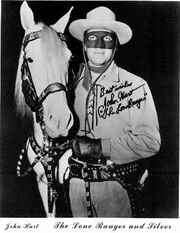
John Hart
In 2003 the WB television network sought to create a new Lone Ranger TV series, and commissioned a two-hour pilot episode. Chad Michael Murray was cast as the Ranger. The producers changed multiple aspects of the story, including the Ranger's real name (to Luke Hartman), to try and attract the teenage Dawson's Creek audience. The pilot was not well received, and a new series never produced.
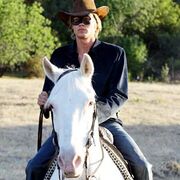
Chad Michael Murray
Films
The first filmed version of the Lone Ranger was a 15 chapter movie serial in 1938. Titled 'The Lone Ranger,' it starred Lee Powell as the Masked Rider, but was actually designed to leave both the villains, and audience, guessing which of five men was, in fact, the Lone Ranger. This serial was later edited into a feature under the title 'Hi-Yo Silver.' A second serial, 'The Lone Ranger Rides Again,' also 15 chapters, followed in 1939. This time Robert Livingston took over the role.
Clayton Moore took the character from the TV screen to the movie screen for two full-length motion pictures. The first, 1956's 'The Lone Ranger' from Warner Brothers, was the first time the Ranger appeared on film in color. It was released the summer before the TV show's only season of color episodes. The second feature, 1958's 'The Lone Ranger and the Lost City of Gold' from United Artists, was the last time Moore would offically play the character, as it was released after the TV series' cancellation.
The Lone Ranger returned to the big screen in 1981 with the big-budget 'The Legend of the Lone Ranger.' Klinton Spilsbury played the title character this time, though his dialogue was overdubbed by James Keach. The film retold the origin story of the Ranger. This film was a major flop at the box office, partly because of the public relations nightmare it caused. In an effort not to 'confuse' the fans, the producers of the film got a court-order preventing Clayton Moore from appearing in public with the mask on. Because Moore had been making public appearances in costume since the television show was on, and everyone remembered him as the Lone Ranger, this was not a move looked upon favorably by the general public. The movie suffered terribly from this, and there has not been a new motion picture since.

Klinton Spilsbury
Besides the PR disaster, 'Legend' is the first time the Lone Ranger is officially given a full name. His last name was obviously Reid, but throughout the radio and TV series a first name was never given. This movie is the first "official" appearance of the name John (the name previously appeared in book about the history of radio), which has been given the character since.
Dynamite Entertainment
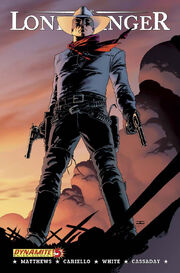
Dynamite Entertainment's Lone Ranger
In 2006, Dynamite Entertainment began a new comic book series based on the Lone Ranger legend. The series began with a six-issue story-arc retelling the origin of the Lone Ranger. This re-imagining of the story featured some alterations from previous versions. Most notably, Butch Cavendish, though he ordered the ambush, did not lead it. He was elsewhere pursuing political ambitions. Also, the addition of Julius Bartholomew, a.k.a. Black Bart, as Cavendish's enforcer sent to ensure all the Rangers were killed. Additionally, Dan Reid did not lead the Rangers into the ambush. Instead, the captain is James Reid, father of Dan and John. This series shows John Reid experiencing many more growing pains than previously shown, on his way to becoming the Lone Ranger.
